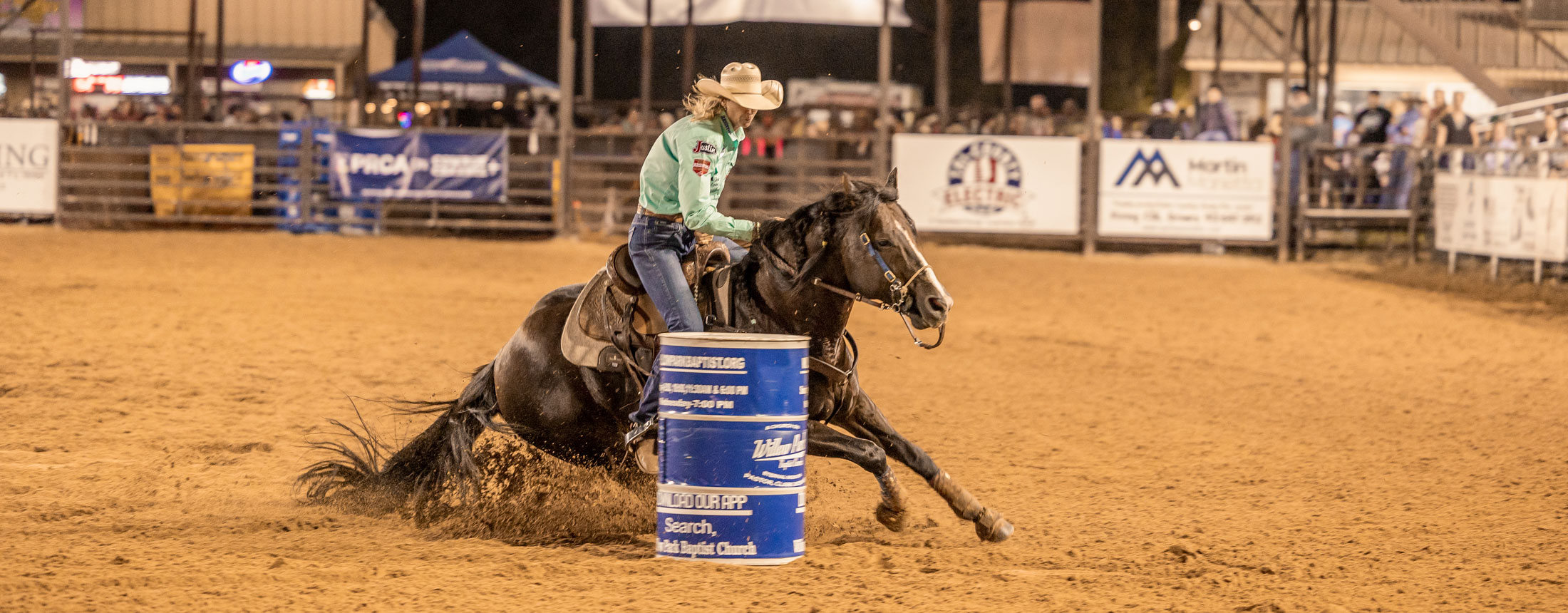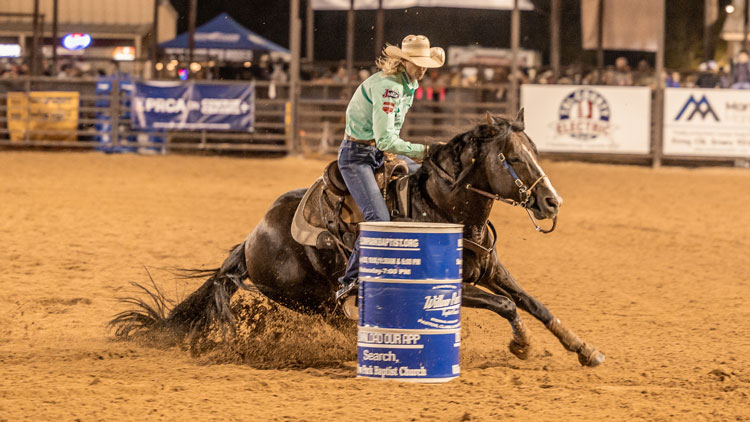

Rodeo Events
In rodeo, the horses and cattle are not outfitted with any special equipment or gear. The animals compete using only their natural abilities and instincts. This is one of the reasons why rodeo is such a unique and challenging sport. In the rough stock events, like bareback riding, saddle bronc riding, and bull riding, the rider must stay on the animal for 8 seconds while the animal tries to buck them off. The rider is not allowed to touch the animal with their free hand and is scored based on their form and style, as well as the animal's bucking ability.
In the timed events, like barrel racing, steer wrestling, team roping, breakaway roping, and tie-down roping, the objective is to complete the task as quickly as possible. In barrel racing, the rider must navigate a cloverleaf pattern around three barrels in order to get the fastest time. In steer wrestling, the cowboy must slide off their horse onto a running steer and wrestle it to the ground. In team roping, two contestants compete alongside each other as a team. This team consists of a header and a heeler. The header must catch the steer first and turn him to the left, allowing the heeler to catch two heels, just as they would do when doctoring stock back on the ranch. The breakaway roping event consists of a cowgirl roping a calf out of the roping chute with a rope loosely tied onto her saddle, breaking the rope away when the calf reaches the point of tension, therefore breaking away from the saddle. In tie-down roping, a cowboy ropes a calf out of the roping chute, dismounts his horse and ties three of the calf's legs.
While rodeo events may seem harsh or challenging to some, they are a testament to the skill and bravery of both the riders and the animals. Rodeo remains an important part of Western culture and heritage and continues to attract fans and competitors from all over the world.
Bareback Riding
In bareback riding, the rider must stay on the horse for eight seconds with only one hand holding onto a leather rigging which has a suitcase-like handle and is cinched onto the horse's back at the girth. The rider must mark out their horse, which means their feet must be held forward in a position over the break of the horse's shoulders until the horse's front feet pass the plane of the gate and contact the ground on the first jump out of the chute.
The rider's score is determined by their skill in maintaining upper body control while synchronizing their feet in a rhythmic, toes-turned-out movement that matches the horse's bucking action.
The horse is also judged based on their bucking ability, speed, agility, and overall performance. The horse's performance is an important factor in the rider's score, as a difficult or unpredictable horse can make it more challenging for the rider to stay on for the full eight seconds.
Bareback riding is a thrilling and challenging event that requires both skill and courage from the rider. It remains a popular event in rodeo and attracts many talented competitors from all over the world.
Steer Wrestling
Steer wrestling was originally called "bulldogging" because it was thought to resemble the way a bulldog would take down a bull. A cowboy who participates in steer wrestling is called a "bulldogger."
The bulldogger backs into the left side of a three-sided fence called a box. Joining the bulldogger in the box is the “hazer” who helps the cowboy during the event. The hazer rides on the opposite side alongside the steer on horseback and helps to keep the animal running straight, making it easier for the bulldogger to slide off on the right and wrestle the steer to the ground, ensuring all four legs are parallel to the ground.
The steer starts in the chute and is given a head start with a “score line,” which is the distance the steer can run before the barrier is released. The barrier is a pulley system released by a tiny rope attached to the steer and releases upon the steer’s exit out of the chute.
Steer wrestling is a physically demanding event that requires both strength and skill from the cowboy. A desired time in steer wrestling is around 4 seconds. However, it’s more common to receive a slower time based on the length of the scoreline and the arena size.
Saddle Bronc Riding
Saddle bronc riding is often referred to as Rodeo’s ‘classic’ event. It requires a great deal of skill and athleticism from both the rider and the horse. In this event, the rider sits on a specially designed hornless saddle that is attached to the horse's back with a cinch at the girth and a flank strap. The rider must hold onto a thickly braided rein called a “bronc rein” attached to the horse's halter. The rider must keep both feet in the stirrups throughout the ride.
Like in bareback riding, the goal of saddle bronc riding is to stay on the horse for a full eight seconds while the animal tries to buck the rider off. The rider is judged on their spurring technique, their balance, and their overall performance. They must spur the horse in a sweeping motion from the horse's shoulder to the rear of the saddle, and they must maintain control of their body and the rein throughout the ride.
However, unlike in bareback riding, there are additional rules in saddle bronc riding that can result in disqualification. If a rider loses a stirrup or drops the rein during the ride, they will be disqualified.
Saddle bronc horses are typically larger and heavier than bareback horses, weighing several hundred pounds more. They are also known for bucking in a slower, more sweeping motion, which can make it more difficult for the rider to maintain their balance and control.
Barrel Racing
Barrel racing is a popular rodeo event that tests a cowgirl's horsemanship, speed, and agility. It consists of a horse race with turns, and the cowgirl's time begins as she rides her horse across the starting line in the arena.
Once the cowgirl has crossed the starting line, she must then navigate her horse around three upright barrels in a cloverleaf pattern. The barrels are set up in a triangle shape, with one barrel at the top and the other two at the bottom corners. The cowgirl must ride her horse around each barrel, making tight turns and using her horse's agility to navigate the course as quickly as possible.
After completing the cloverleaf pattern, the cowgirl must then ride her horse back to the starting line where the clock stops. Tipping a barrel is permitted, meaning that a cowgirl can touch a barrel and still remain eligible for a winning time. However, if a barrel is knocked to the ground, a five-second penalty is added to the cowgirl's time, which can greatly impact her final score.
Barrel racing requires a great deal of skill, speed, and precision from both the rider and their horse. The cowgirl must be able to communicate effectively with her horse and anticipate its movements, while the horse must be agile, responsive, and able to make tight turns at high speeds.
Overall, barrel racing is a thrilling event enjoyed by both riders and spectators. It is a testament to the rich history and traditions of the American West and remains a popular event in rodeos and other Western competitions around the world.
Team Roping
Team roping is a rodeo event that requires two contestants to work together. The team consists of a header and a heeler, and their goal is to rope and stop a steer as quickly and accurately as possible.
In team roping, the header uses his roping skills to catch the steer's horns and subsequently secures the rope around his saddle horn through dallying or wrapping techniques in order to direct the steer to the left. This enables the heeler to throw a loop with near-perfect timing to catch both of the steer's back legs.
Timing and communication are crucial in team roping. The header and heeler must work together seamlessly to ensure that they can make their catches as quickly and accurately as possible. The heeler must time their throw perfectly to catch the steer's hind legs, while the header must turn the steer in just the right way to set up the heeler's shot.
Once both ropers have successfully made their catches and brought the animals to a complete stop, facing each other, the time clock comes to a halt. A quick time requires both ropers to be skilled and precise in their movements, and a well-executed run can be a thing of beauty to watch.
Bull Riding
Bull riding is a popular and exciting rodeo event that requires a great deal of strength, skill, and courage from the rider. In this event, the rider must place a flat braided rope around a bull that weighs almost 2000 pounds. The bull rope is positioned around the bull, specifically behind its shoulders. The rider's task is to loop and thread the rope through itself and then wrap it securely around their riding hand, relying solely on their grip to maintain their position.
The goal of bull riding is to stay on the bull for a full eight seconds while the animal tries to buck the rider off. The rider relies on their balance and leg strength to stay on the bull while also using their riding style to impress the judges. The bull's bucking ability is also a key factor in the rider's score, and the animal's strength and agility can make it difficult for the rider to stay on.
Bull riders are typically smaller in size, with many weighing less than 150 pounds. They must be extremely fit and strong to withstand the power and force of the bull. Riders will often sit up close to their bull ropes and turn their toes out in order to maintain their balance and grip on the animal.